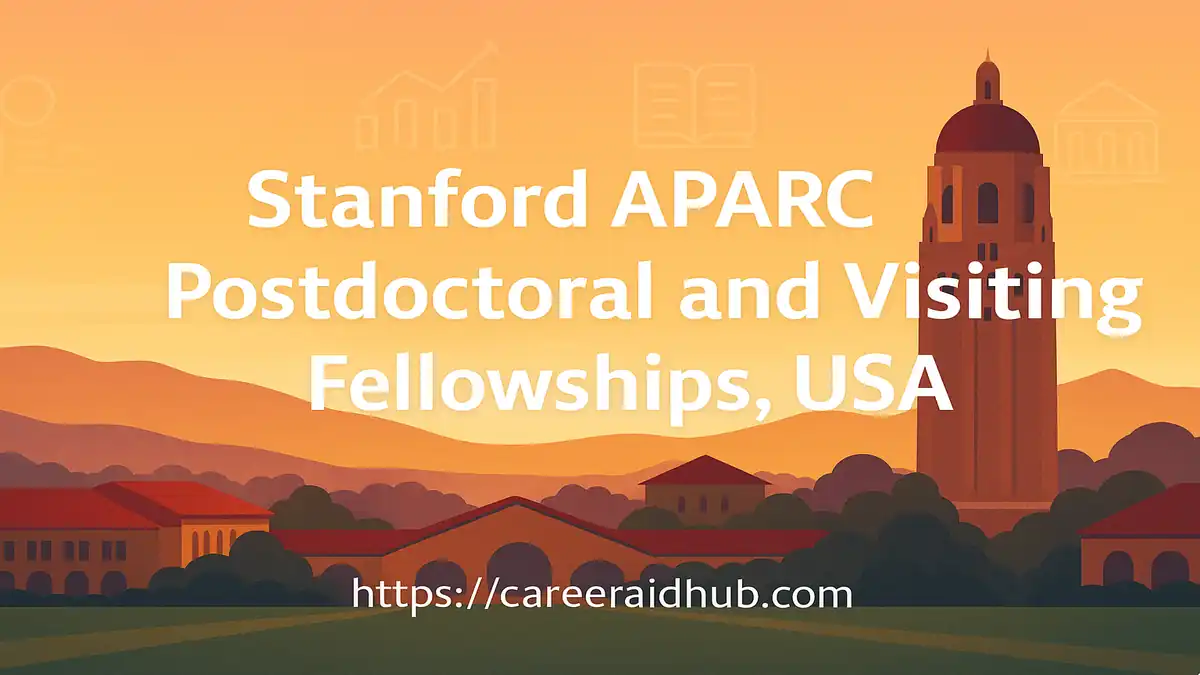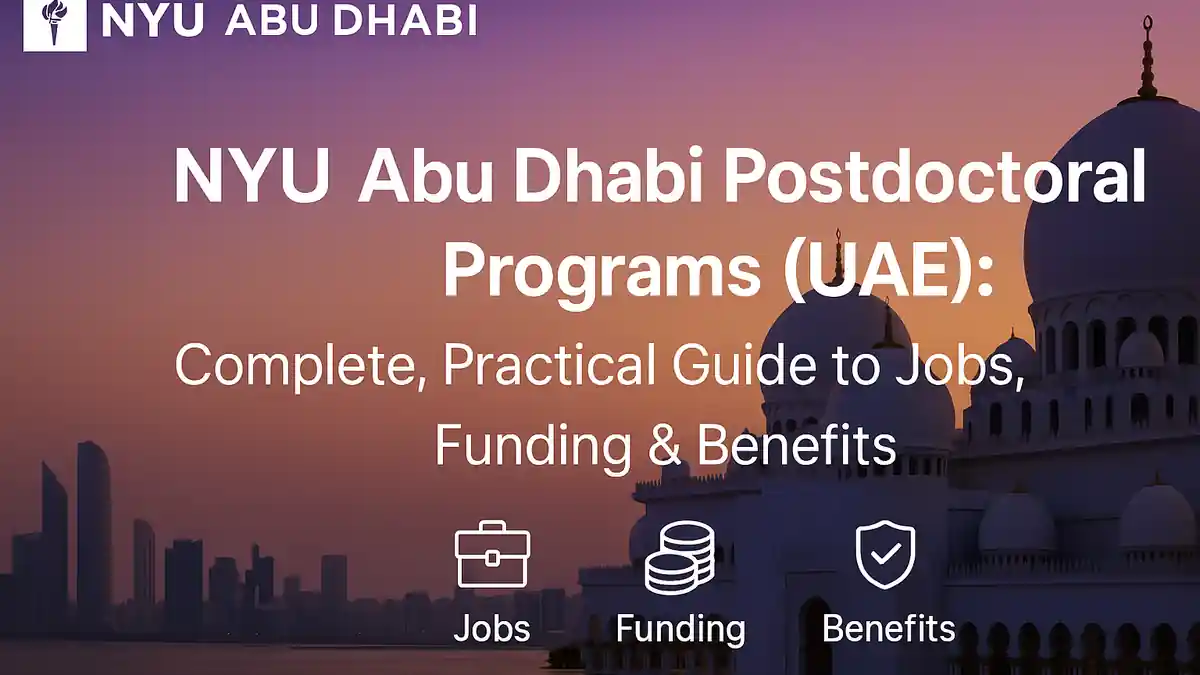Introduction: A Focused Gateway to Stanford APARC Postdoctoral Fellowships
If your research is rooted in contemporary Asia – covering health systems, political transitions, nationalism, Japan, Taiwan, or U.S.–Asia relations – the fellowships at Stanford University’s Walter H. Shorenstein Asia-Pacific Research Center (APARC) are designed precisely for you.
Stanford’s Asia-Pacific Research Center (APARC) fellowships for 2026–2028 support early and mid-career scholars conducting advanced research on contemporary Asia, including health policy, political transitions, nationalism, Japan, Taiwan, and U.S.–Asia relations, while offering protected research time, competitive funding, mentoring, and deep integration into Stanford University’s globally connected, policy-focused academic community.
APARC has announced a coordinated suite of postdoctoral and visiting fellowships for the 2026–2028 cycle. These positions begin in Fall 2026 and usually extend through 2027 or 2028, depending on the specific fellowship track. Together, they form a coherent portfolio aimed at recent PhD graduates and more experienced professionals who want to deepen their engagement with policy-relevant research on the Asia-Pacific region.
What Is APARC?
APARC is Stanford University’s main center for interdisciplinary research and policy dialogue on Asia’s key challenges. It is part of the Freeman Spogli Institute (FSI) and brings together faculty, postdocs, students, and practitioners working on politics, economics, security, health, society, and foreign policy across the Asia-Pacific.
The center does far more than
The next section gives a brief overview of the full 2026–2028 APARC fellowship portfolio before explaining each track in detail.
Overview of the 2026–2028 APARC Fellowships
According to APARC’s official call for applications, the 2026–2028 fellowship portfolio is composed of several complementary programs. Collectively, they cover health policy, contemporary Japan, broader Asia studies, and the policy-focused work of the Stanford Next Asia Policy Lab (SNAPL), along with a dedicated Taiwan program:
-
- 2026–27 Asia Health Policy Program Postdoctoral Fellowship
- 2026–27 Japan Program Postdoctoral Fellowship
- 2026–27 Shorenstein Postdoctoral Fellowship on Contemporary Asia
- 2026–28 Stanford Next Asia Policy Lab (SNAPL) Postdoctoral Fellowships
- 2026–27 SNAPL Visiting Fellow Positions
- 2026–27 Taiwan Program Visiting Fellowship)
Most of the Stanford APARC postdoctoral fellowships are one academic year in length and commence in Fall 2026. The SNAPL postdoctoral fellowships extend to two years (2026–2028), which reflects their lab-based structure and emphasis on sustained, collaborative policy engagement.
Key deadlines for the current
cycle include:
-
- 1 December 2025 – Asia Health Policy Program, Japan Program, Shorenstein Postdoctoral, and SNAPL Postdoctoral Fellowships
- 1 March 2026 – SNAPL Visiting Fellowships and the Taiwan Program Visiting Fellowship
Looking ahead, and based on the current timetable, the next expected call for Stanford APARC fellowships is likely to open around September 2027, with anticipated deadlines in December 2027 (for postdoctoral tracks) and March 2028 (for visiting fellowships). Exact dates will be confirmed by APARC; we will update this section once new information becomes available.
Asia Health Policy Program Postdoctoral Fellowship (2026–27)
Academic Focus and Objectives
The Asia Health Policy Program (AHPP) Postdoctoral Fellowship supports a recent PhD carrying out original research on health or healthcare policy in the Asia-Pacific region, with a particular focus on developing and middle-income countries. The program seeks evidence-based, comparative work that speaks directly to the design, implementation, and evaluation of health policy reforms across Asia.
Typical projects may analyze health system performance, health financing and insurance reforms, demographic change, or the links between health policy and social protection. Interdisciplinary approaches that draw on public policy, public health, economics, sociology, demography, political science, and related disciplines are especially encouraged.
Duration, Funding, and Expectations
The Stanford APARC health policy fellowship is a 10-month postdoctoral position aligned
The fellow must remain in residence at Stanford for the entire term. They present their work in APARC seminars and support the center’s publication efforts. This also means regularly joining AHPP events, workshops, and policy discussions, and collaborating closely with faculty and other postdocs.
Eligibility Snapshot
Applicants are generally expected to be no more than three years beyond the award of their PhD (or six years beyond an M.D.) at the start of the fellowship. They must also have their doctoral degree formally conferred before the fellowship begins, typically by June 30, 2026, in order to be eligible for the 2026–27 cohort.
Japan Program Postdoctoral Fellowship (2026–27)
Research Themes and Disciplinary Scope
The Japan Program Postdoctoral Fellowship supports research on contemporary Japan across fields such as political science, economics, sociology, law, public policy, and international relations. It is especially suitable for scholars studying Japan’s domestic institutions and its changing role in the Asia-Pacific.
Projects may explore topics
Duration and Eligibility
These are one-year postdoctoral appointments beginning in Fall 2026. Eligible candidates are recent PhD graduates working on Japan-related topics in the social sciences, public policy, or related fields. The application deadline is December 2025, aligned with other APARC postdoctoral programs.
This fellowship suits scholars who want to strengthen their Japan studies profile and join an international community of Japan specialists at Stanford and its partner institutions.
Shorenstein Postdoctoral Fellowship on Contemporary Asia (2026–27)
Broad Regional and Thematic Coverage
The Shorenstein Postdoctoral Fellowship on Contemporary Asia is APARC’s most regionally wide-reaching track. It offers two positions each year for junior scholars studying political, economic, or social change in the Asia-Pacific, as well as the region’s international relations and political economy.
Research topics may include governance, political transitions, inequality, development, social movements, migration, identity, regional integration, or Asia’s role in global governance. Because of its broad focus, this Stanford APARC fellowship suits comparative or multi-country projects that do not fit easily into narrower programs like health policy or Japan studies.
Key Features and Applicant Profile
-
- Focus areas:
- Political transitions and governance in Asia
- Economic development, inequality, and institutional change
- Social change, identity, and migration
- International relations and international political economy
- Duration: One academic year beginning in Fall 2026
- Eligibility: Early-career PhDs with strong research portfolios on contemporary Asia, broadly defined
- Deadline: December 2025
- Focus areas:
This track is particularly attractive for scholars keen to convert a dissertation or major research project into high-impact publications, while engaging with a wider regional community at Stanford.
Stanford Next Asia Policy Lab (SNAPL) Postdoctoral Fellowships (2026–28)
SNAPL’s Policy-Oriented Mission
The Stanford Next Asia Policy Lab (SNAPL) is a major initiative within APARC that addresses emerging social, cultural, economic, and political challenges in Asia through interdisciplinary, problem-driven, and policy-relevant research. It is organized around four core themes:
-
- Talent Flows and Development
- Nationalism and Racism
- U.S.–Asia Relations
- Democratic Crisis and Reform
These themes provide the framework for SNAPL’s research programming, student engagement, and public-facing activities.
Structure of the Postdoctoral Fellowships
For the 2026–28 cycle, SNAPL will appoint two postdoctoral fellows to two-year positions starting in Fall 2026. Each fellow leads one thematic research group, contributes to solo and collaborative publications, and plays an active role in student programming and broader lab activities.
Key features include:
-
- Duration: Two years, with the possibility of extension subject to performance and funding
- Compensation: Annual salary of USD 80,000 plus benefits, in line with Stanford postdoctoral policy
- Responsibilities: Leadership of a thematic research cluster, collaboration with faculty and other fellows, mentoring of students, and participation in APARC and FSI seminars and events
Eligibility and Deadline
Applicants should have completed their PhD within three years of the fellowship start date. They must also show a strong interest in policy-engaged research and be prepared to work with colleagues across SNAPL’s themes. The deadline for the 2026–28 SNAPL postdoctoral cohort is December 2025.
For scholars aiming to influence both academic debates and policy discussions, SNAPL provides a strong platform at the intersection of research and practice.
SNAPL Visiting Fellowships (2026–27)
Target Group and Thematic Focus
SNAPL offers two visiting fellow positions for 2026–27, in addition to its postdoctoral roles. These positions are open to researchers and professionals from the Asia-Pacific region, including mid-career scholars and senior practitioners. One position focuses specifically on the Philippines, highlighting SNAPL’s commitment to grounded, country-specific policy work.
Visiting fellows develop projects aligned with SNAPL’s core themes. They work closely with postdocs, faculty, and students, and benefit from a collaborative research environment.
Duration, Support, and Eligibility
-
- Duration: One academic year (2026–27), starting in Fall 2026
- Stipend: A supplementary stipend (currently USD 30,000) to offset living costs, plus access to Stanford’s research facilities and the opportunity to audit relevant courses
- Eligibility: Candidates typically hold a PhD or possess a substantial record of professional achievement in fields related to SNAPL’s themes
Applications for the 2026–27 visiting fellowships are due by March 2026. This track is particularly attractive for practitioners who want to pause, reflect, and write, while situating their experience in a comparative, research-intensive environment.
Taiwan Program Visiting Fellowship (2026–27)
Focus on Contemporary Taiwan
The Taiwan Program Visiting Fellowship supports mid-career to senior experts working on contemporary Taiwan. Projects may explore economic restructuring, technological change, energy and environmental transitions, social reform, or Taiwan’s complex international position.
Taiwan’s role in global supply chains, technology ecosystems, and democratic debates makes this Stanford APARC fellowship especially appealing. It is particularly relevant for work on semiconductor policy, cross-strait relations, democratic resilience, and industrial transformation.
Duration and Applicant Profile
The fellowship runs for one year starting in Fall 2026, and applications are due by March 2026. Applicants should already have a strong record of scholarship or professional leadership on Taiwan. They should also be ready to engage with APARC’s community and, when relevant, contribute to SNAPL’s work.
Who Should Consider Applying?
These Stanford APARC fellowships are especially suitable for:
-
- Recent PhDs and late-stage doctoral candidates in social sciences, public health, law, economics, public policy, or international relations with a strong Asia-Pacific focus
- Mid-career and senior scholars working on Taiwan or broader regional themes who are seeking a concentrated year of research time in a leading global university environment
- Policy practitioners and professionals from the Asia-Pacific region, particularly those whose work intersects with SNAPL’s four themes and who want to connect hands-on experience with rigorous academic analysis
Because APARC and SNAPL are highly interdisciplinary, candidates who combine qualitative and quantitative methods, undertake comparative research, or work at the intersection of academia and policy are especially competitive.
For additional context on related opportunities, you may wish to consult your institution’s research office or explore other fully funded postdoctoral fellowships in the USA, which can complement the Stanford APARC options within a broader long-term career strategy.
Why These Fellowships Matter
Research Environment and Career Impact
Spending a year or two at APARC offers benefits that extend far beyond a single line on your CV:
-
- Dedicated research time and resources – Fellows receive competitive salaries, targeted research support, and full access to Stanford’s libraries, data resources, and seminar series.
- High-impact intellectual environment – Daily interaction with faculty, visiting scholars, and students working on overlapping issues across Asia helps refine your research questions, methods, and contributions.
- Policy engagement and public impact – APARC and SNAPL are explicitly committed to translating academic research into policy-relevant outputs, including policy briefs, op-eds, and practitioner-oriented reports.
- Career stepping stone – Alumni from related APARC programs frequently move into tenure-track roles, senior research positions in think tanks, and leadership posts in international organizations and government agencies.
By positioning your work at the intersection of scholarship and policy, these Stanford APARC fellowships can substantially accelerate both your publication pipeline and your professional network.
How to Approach Your Application
Core Documents You Will Need
Although each fellowship has its own application portal, most APARC and SNAPL tracks require a common set of core materials:2
-
- A research proposal clearly aligned with the themes of the specific fellowship you are targeting
- A current academic CV, including publications, conference presentations, and relevant fieldwork or policy experience
- One or more writing samples, often a dissertation chapter, peer-reviewed article, or policy paper
- Letters of recommendation (commonly three for postdoctoral tracks, and two for some visiting fellowships)
In addition, certain programs may request a short statement of teaching interests or evidence of prior policy engagement.
Practical Tips to Strengthen Your Application
-
- Align tightly with the specific track
Avoid generic proposals. Refer explicitly to the Asia Health Policy Program, Japan Program, Shorenstein Fellowship, SNAPL, or Taiwan Program, and explain how your project advances the priorities of that fellowship. - Demonstrate regional expertise and language skills
Fieldwork experience, collaboration with Asian institutions, or proficiency in relevant languages shows long-term commitment and the capacity for nuanced, context-sensitive research. - Highlight policy relevance
Especially for SNAPL and the Taiwan Program, make clear how your research addresses current policy debates or institutional challenges and how it could inform decision-making in practice. - Plan realistic outputs
Specify what you intend to produce during the fellowship – for example, one journal article and one policy brief – and explain how these outputs fit into your broader research and career agenda.
- Align tightly with the specific track
For additional guidance on preparing a competitive application, Stanford’s Office of Postdoctoral Affairs provides useful resources on life as a postdoc. Many universities also publish model research statements and CV templates that can help you benchmark and refine your materials.
Final Thoughts
The 2026–2028 APARC and SNAPL fellowships offer broad opportunities for scholars and practitioners working on contemporary Asia. They cover health policy, social and economic change, nationalism, U.S.–Asia relations, and Taiwan’s shifting regional role.
If your work bridges academic research and real-world policy, these Stanford fellowships provide a rare platform to advance it. Application cycles change, so you should check the official APARC pages often. Reviewing them each September and January helps you stay current on eligibility, deadlines, and procedures.
A strong application that aligns your project with the right APARC track can lead to one or two transformative years of research, writing, and policy engagement at the center of global discussions on Asia.
Program Snapshot: Key Fellowship Details
The table below summarizes the essential features of the Stanford APARC fellowship suite in a single, scan-friendly format.
|
Feature |
Details |
|
Program Name |
Fellowships at Stanford’s Asia-Pacific Research Center (APARC), 2026–2028 |
|
Host Country |
United States of America (Stanford University, California) |
|
Funded By |
Walter H. Shorenstein Asia-Pacific Research Center (APARC), Freeman Spogli Institute for International Studies, Stanford University |
|
Duration |
10–24 months: most postdoctoral and visiting fellowships are 1 academic year; SNAPL postdoctoral fellowships run for 2 years (2026–2028) |
|
Study Mode |
Full-time, residential, on-campus appointments at Stanford University |
|
Eligibility |
Recent PhD graduates (for postdoctoral tracks) and mid-career or senior scholars/professionals (for visiting tracks), with projects focused on contemporary Asia (track-specific criteria apply) |
|
Financial Support |
Competitive postdoctoral salary (currently around USD 80,000 per year, prorated for a 10-month appointment) plus USD 3,000 research support in some tracks, together with benefits and access to Stanford resources, in line with Stanford policy |
|
Fields of Study |
Asia health policy, contemporary Japan studies, comparative politics, sociology, economics, public policy, international relations, Taiwan studies, and broader Asia-Pacific social science fields |
|
Deadline |
Current cycle: December 2025 (most postdoctoral tracks) and March 2026 (visiting tracks). Next expected cycle: December 2027 and March 2028 – exact dates to be confirmed; we will update soon. |
|
Official Website |
Click here |
References
Applications Open for 2026–2028 Fellowships at Stanford’s Asia-Pacific Research Center – APARC, Stanford University
Stanford Next Asia Policy Lab (SNAPL) Fellowships – APARC, Stanford University
Frequently Asked Questions (FAQs)
Stanford APARC’s 2026–2028 postdoctoral fellowships fund early-career scholars on contemporary Asia, offering salary, research support, and full-time residency across several thematic programs.
Recent PhD graduates in social sciences, public health, economics, law, or related Asia-focused fields can usually apply, though each APARC program has its own rules.
es, international scholars may apply, but they must meet academic requirements and obtain the appropriate U.S. visa under Stanford’s policies.
The fellowships support interdisciplinary research in Asia health policy, Japan and Taiwan studies, politics, sociology, economics, public policy, international relations, and broader Asia-Pacific social sciences.
These fellowships are highly competitive, so selected applicants typically show strong publications, solid methods, regional expertise, and clear potential for high-impact or policy-relevant work.
Apply through Stanford APARC’s online portals, submitting a research proposal, CV, writing samples, and recommendation letters as required.
Postdoctoral fellows usually receive a competitive annual salary and research funds. They also get health benefits and office space. In addition, they have full access to Stanford libraries, seminars, and other campus resources.
Some programs may consider PhD candidates near completion, but final selection usually requires the degree to be awarded before the fellowship starts.
Premium Mentorship for a Stronger Application
- Premium Mentorship: personalised 1:1 guidance for this and similar opportunities
- In-depth review of your CV, academic profile, and key statements
- Aligned with international selection criteria so your profile matches what panels expect
- Stronger, more compelling narrative for highly competitive calls
- Step-by-step support from opportunity mapping to final submission (fee-based)










